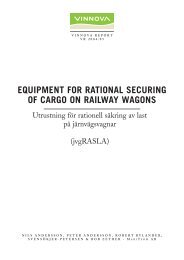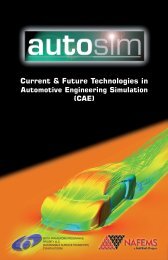WP3: Rail Passenger Transport - TOSCA Project
WP3: Rail Passenger Transport - TOSCA Project
WP3: Rail Passenger Transport - TOSCA Project
Create successful ePaper yourself
Turn your PDF publications into a flip-book with our unique Google optimized e-Paper software.
Summary and comments<br />
- Some of the investigated technologies do not influence the total operating cost significantly<br />
if energy cost is excluded. There is however a tendency of decreasing operating cost when<br />
Energy recovery or Eco-driving is applied, because of less frequent use of the mechanical<br />
brakes, which leads to reduced maintenance of these brakes. However, on some rail<br />
networks increased energy recovery requires the electrical supply system to be rebuilt or<br />
upgraded in order to be receptive for an increased amount of feed-back electric energy. In<br />
the long term however this is anyhow an anticipated development.<br />
- The most cost-saving measure is to increase space utilization (essentially this is the number<br />
of seats per metre length of train), by changing from loco-hauled trains to multiple units<br />
and/or by increase the space efficiency of interiors.<br />
- Reduced mass per metre of train tends to increase cost if energy cost is excluded. This is<br />
due to higher production cost of the train, and thus investment and capital cost, assumed to<br />
be 20 EUR per kilogram of reduced mass (which is about half of the average price per<br />
kilogram of the whole train). However, this estimate is not confirmed, due to a lack of<br />
reliable sources for long-term estimations. Track charges and train maintenance costs will<br />
be lower for low-mass trains, which partly compensates for higher capital cost. With about<br />
50 % increased prices of electricity (relative to 2009) the ‘low-mass’ train, with assumed<br />
costs of mass reduction, is about to break even in a long-term economic perspective. For<br />
’Local city trains’ with frequent stops, low mass will save more energy and GHG per<br />
average pkm, but the relatively low utilization (km per year) of these trains will limit the<br />
benefits to moderate levels. Due to the current uncertainties on cost and the underdeveloped<br />
technology of low mass trains, a comprehensive R&D program is recommended.<br />
- Low drag is long-term beneficial for ‘High-speed trains’ and also for the ‘Intercity or<br />
regional’ segment, if current energy prices are applied, and still more at higher energy<br />
prices.<br />
- The used interest rate for increased vehicle investment is chosen from a long-term<br />
perspective and is not including profit margins in profit-making operating companies. This<br />
fact indicates that additional incentives – except energy cost savings - may be required for<br />
some technologies.<br />
- Higher speed is usually beneficial for the operator from a cost point of view, due to<br />
increased mileages both for trains and for the train crew. This is in spite of slightly<br />
increasing cost of trains as well as for maintenance and energy. In addition, considerations<br />
must be taken to the increased willingness to pay for shorter travel time; see Section 5.6, in<br />
particular Table 5-8.<br />
Deliverable D4 – <strong>WP3</strong> passenger 29
















